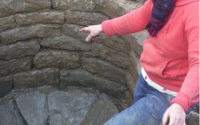What’s on : Lectures
Event Information
New Light on Roman Yorkshire: work by students at the Department of Archaeology
Steve Roskams, Senior Lecturer, University of York
This talk will draw together the results of Departmental excavations over recent decades at Wharram Percy on the Wolds, the Malton fort, and Heslington East near York. In doing so, it aims to assess their implications for the impact of Rome in the region, in particular how imperial authority changed, and was itself changed by, local society.
The talk will be hosted on Zoom – contact us for further details
Image: A late Roman masonry well from Heslington East – part of the monumentalisation of that landscape in the late Roman period.
Member’s report
Student fieldwork provides students with training in real archaeology and three such projects, at Wharram Percy, the Malton fort and Heslington East respectively, were discussed. The aims of the excavations included research into the evolving relationship between Roman settlement and both landscape and town-hinterland, and transitions between Roman and post-Roman. It seems the organisation of local society survived into and beyond the Roman period.
Wharram Percy excavations revealed prehistoric trackways, Iron Age and early-Roman ladder settlements, replaced later by Roman enclosures with evidence of pottery, specialised meat production and crop processing. Remains of a ‘villa’ on a local hill suggested possible surveillance. At Malton a Roman settlement showed road works, prestigious domestic buildings, a diverse range of burials and commercial, and rural processing but no evidence of clear military involvement as only later levels have been excavated so far. At Heslington there is evidence that pre-Roman landscape organisation survived over many decades and into the Roman period. Food production increased with some orientation towards York, although there was limited ability for York to dictate to rural regimes.
Ken Hutson

